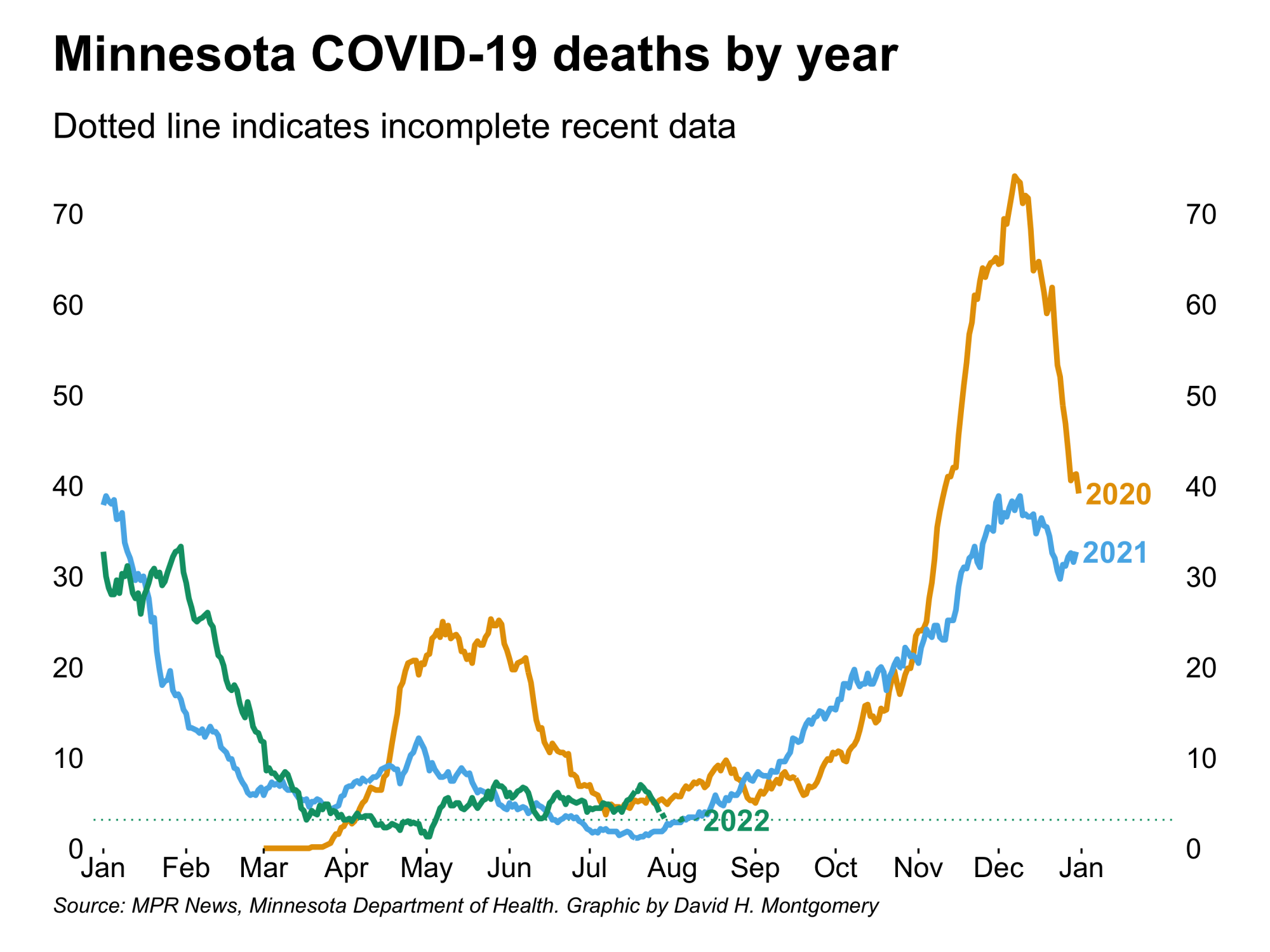CDC notches up Twin Cities’ COVID risk rating heading into ‘the Great Minnesota Get-Together’

Go Deeper.
Create an account or log in to save stories.
Like this?
Thanks for liking this story! We have added it to a list of your favorite stories.
Last week, the U.S. Centers for Disease Control and Prevention’s community level risk rating map showed the entire Twin Cities seven-county region in green, signaling lower risks. This week the CDC has colored the state’s biggest population center yellow, signaling “medium” risk. Hopefully the risk won’t go up further as we look ahead to the opening of the State Fair next week.
This increase in the CDC’s risk assessment comes despite generally flat case counts and hospitalizations, and very slow but steady decreases in the amount of COVID-19 detected in Twin Cities-area wastewater.
As we'll see, COVID concerns are even higher outside of the Twin Cities, with COVID levels increasing in wastewater and especially high case rates, and high CDC risk ratings, in some Greater Minnesota counties.
Three things to know
1) Department of Health data continues to show cases, hospitalizations, and deaths on a high plateau.
Turn Up Your Support
MPR News helps you turn down the noise and build shared understanding. Turn up your support for this public resource and keep trusted journalism accessible to all.
2) Wastewater: COVID levels up in Greater Minnesota, down ever so slightly in the Twin Cities.
3) Latest CDC Community Level ratings place 18 Minnesota counties at high risk and upgrade the Twin Cities to medium risk.
In this week’s update we are highlighting Minnesota COVID vaccinations and deaths in a national context. In short, Minnesota is generally doing better than most states, but not for all groups.
Cases and hospitalizations continue to be on a high plateau
The new weekly data from the Minnesota Department of Health released yesterday shows a continued “high plateau” among both officially reported cases — now averaging 1,400 new cases per day — and hospital admissions — now averaging 71 per day.

Most plainly, the case and non-ICU hospitalization graphs show that current COVID activity is just about identical to this time last year, when the delta wave was on its way up.

Fortunately, the recent uptick to seven deaths per day has not continued, although the steady drum beat of four deaths per day is still four deaths too many.

Wastewater: COVID levels up in Greater Minnesota, down ever so slightly in the Twin Cities
The latest data out of the University of Minnesota’s Wastewater SARS-CoV2 Surveillance Study shows the continuation of a concerning upward trend in COVID levels from treatment plants in Lyon and Nobles counties in the state’s southwest. The project also shows climbing levels of COVID-19 detected in wastewater in the study’s two northern regions over both the month and week ending Aug. 3.
Central region treatment plants also saw both monthly and weekly increases. The six plants in the South East region also showed a modest weekly increase in COVID levels after a decrease earlier in the month.
The 13 plants in the study’s Metro region, which together serve more than half of the state’s population, notched single-digit decreases in COVID levels, continuing the summer-long slow decline in that region.
The more recent wastewater data from the Metropolitan Council and the University of Minnesota’s Genomic Center, confirms the continued slow decline through Aug. 15. According to the Metropolitan Council “[t]he total viral RNA load entering the Metro Plant decreased by 2% last week compared to a week earlier; it has dropped by 18% since June 21, or about 2.5% per week.”

The Genomic Center’s analysis also confirms that omicron subvariant BA.5 remains dominant at the Metro plant, but with BA.4 increasing somewhat recently. They are testing for BA.2.75, but it has not shown up yet.
In somewhat related news, in response to an inquiry from MPR News’ Phil Picardi last week, the Metropolitan Council tweeted, “Through our wastewater monitoring for SARS-CoV-2, we are aware of the possibilities of also monitoring for other infectious diseases, including monkeypox and polio. Along with our partners, we are assessing the role of wastewater in addressing these developing concerns.”
According to the Community Level ratings released yesterday by the CDC, residents of 18 Minnesota counties (along with 1/3 of all counties nationally) should mask up when in public indoor settings. This is down from 22 counties last week, but includes both St. Louis and Olmsted counties, home to Duluth and Rochester, and newly added Clay County, home to Moorhead.
In addition, the CDC’s new map shifted the entire Twin Cities seven-county region from low-risk green last week to medium-risk yellow this week. This upgraded risk is not great news ahead of the State Fair, which will bring thousands from around the state and region to the Twin Cities.
The CDC bases its community level ratings in part on officially reported COVID-19 case rates. Over the past week all but four of Minnesota’s counties meet the CDC’s definition of “high transmission” with weekly case rates of at least 100 per 100,000 residents. In the week ending Aug. 17, both Todd and Brown counties had case rates above 300 per 100,000, the state’s highest.
For more details and the complete map click here to get to the COVID in Minnesota key data page.
National comparisons: COVID vaccinations and mortality
According to this week’s Inoculation Nation update, Minnesota ranks 20th in terms of the CDC’s definition of full vaccination (one dose of Johnson and Johnson vaccine or two of either the Moderna or Pfizer vaccine), and 7th in terms of the percent vaccinated and boosted.
Notably, that project also shows the national vaccination rate for the newly COVID-vaccine-eligible population of children 6 months to 4 years old at just 4 percent. This compares to the 11 percent of Minnesotans in that age rage who have initiated vaccination as of Aug. 17.
According to this week’s Color of Coronavirus update, which tracks COVID-19 mortality by race and ethnicity for all states and the U.S. as a whole, Minnesota’s age-adjusted mortality rates are higher than the national averages among Indigenous and Asian Americans, and lower than national among Latino, Black and white Americans.



